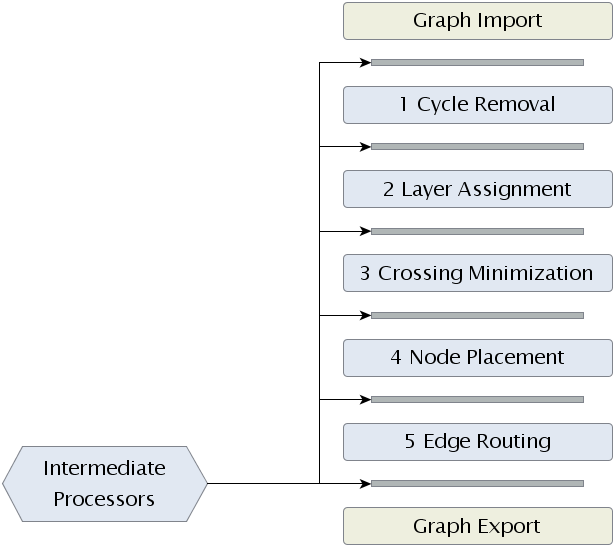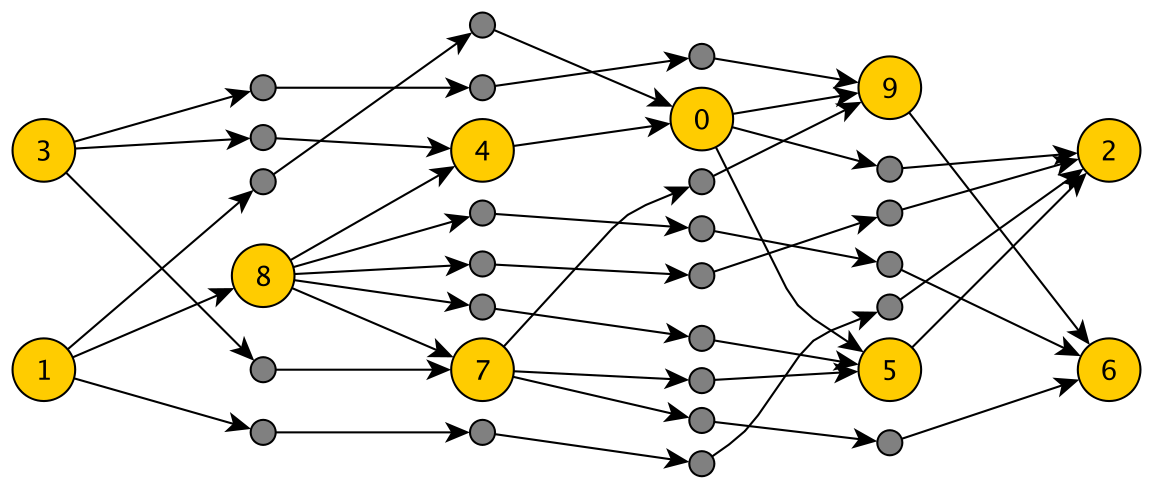KLay Layered is a layer-based layout algorithm mainly intended for diagrams with an inherent data flow direction. This page describes its general architecture, while child pages discuss the different phases, its intermediate processors, and other specialized topics.
Contents
Architecture
To get an idea of how KLay Layered is structured, take a look at the diagram below. The algorithm basically consists of just three components: layout phases, intermediate processors and an interface to the outside world. Let's briefly look at what each component does before delving into the gritty details.
The backbone of KLay Layered are its five layout phases, of which each is performing a specific part of the work necessary to layout a graph. The five phases go back to a paper by someone whose name I'm currently too lazy to look up. They are widely used as the basis for layout algorithms, and can be found in loads of papers on the topic. A detailed description of what each layout phase does can be found below.
Intermediate processors are less prevalent. In fact, it's one of our contributions to the world of layout algorithms. The idea here is that we want KLay Layered to be as generic as possible, supporting different kinds of diagrams, laid out in different kinds of ways. (as long as the layout is based on layers) Thus, we are well motivated to keep the layout phases as simple as possible. To adapt the algorithm to different needs, we then introduced small processors between the main layout phases. (the space between two layout phases is called a slot) One processor can appear in different slots, and one slot can be occupied by more than one processor. Processors usually modify the graph to be laid out in ways that allow the main phases to solve problems they wouldn't solve otherwise. That's an abstract enough explanation for it to mean anything and nothing at once, so let's take a look at a short example.
The task of phase 2 is to produce a layering of the graph. The result is that each node is assigned to a layer in a way that edges always point to a node in a higher layer. However, later phases may require the layering to be proper. (a layering is said to be proper if two nodes being connected by an edge are assigned to neighboring layers) Instead of modifying the layerer to check if a proper layering is needed, we introduced an intermediate processors that turns a layering into a proper layering. Phases that need a proper layering can then just indicate that they want that processor to be placed in one of the slots.
The interface to the outside world finally allows us to plug our algorithm into the programs wanting to use it. While not strictly part of the actual algorithm, that interface allows us to lay out graphs people throw at us regardless of the data structures used to represent those graphs. Internally, KLay Layered uses a data structure called LGraph to represent graphs. (an LGraph can be thought of as a lightweight version of KGraph, with the concept of layers added) All a potential user has to do is write an import and export module to make his graph structure work with KLay Layered. Currently, the only module available is the KGraphImporter, which makes KLay Layered work with KIML.
Dummy Nodes
Before getting down to it, one other thing is worthy of our attention: dummy nodes. Dummy nodes are nodes inserted into the graph during the layout process. They were not in the original graph that is to be laid out, and are removed prior to the layout being applied to the original graph structure. So why then do we need them?
The different layout phases often have very specific requirements concerning the graph's structure. Real-world graphs usually don't meet these requirements. We could of course respond to that by enabling the phases to cope with these kinds of adverse conditions. But it's much simpler to just insert a few dummy nodes to make the graph fit the requirements.
See the graph below for an example. The orange nodes were layered, but the layering was by no means a proper layering. Thus, gray dummy nodes were added.
In KLay Layered, we make extensive use of dummy nodes to reduce complex and very specific problems such that we can solve them using our general phases. One example is how we have implemented support for ports on the northern or southern side of a node.

